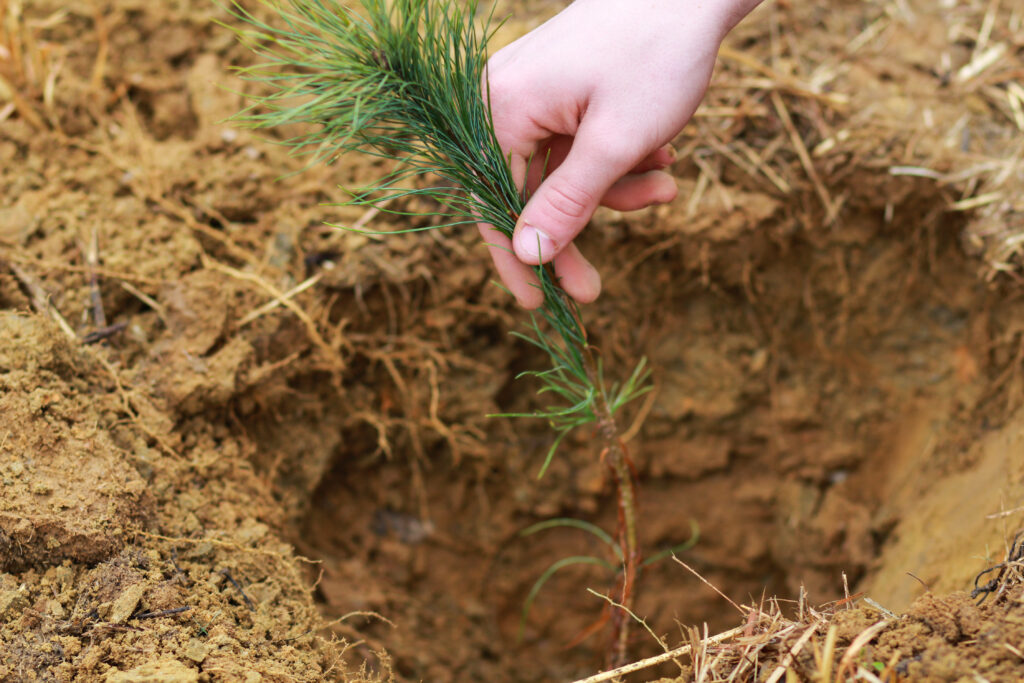In recent years, consumers have become more aware of the impact of holiday festivities on the environment. Increased consumption and waste add a dark undertone to a happy and festive time.
Many families are exploring ways to minimize their impact while maximizing their Christmas experience. One of the burgeoning trends in recent years is growing your own Christmas tree.
In this article, we’ll cover how to grow your own Christmas tree, from choosing the right species to ensuring its longevity.
Let’s dig in!
Choose the Right Christmas Tree Species

Douglas Firs are the most popular Christmas tree.
©arlutz73/iStock via Getty Images
There are several tree species that bear the Christmas tree label, each with its own benefits and downsides. While consumers shopping for an annual tree focus on heft, scent, and lifespan after harvesting, you need a different approach when growing your own Christmas tree.
The key considerations include where you live and how you intend to use the tree. The most common Christmas tree types are pines, spruces, and firs, which typically do well in cooler climates and struggle in higher USDA zones. People in Southern regions often use a cypress or cedar tree instead.
USDA Zone and Climate
The first consideration is your USDA zone and climate. Some tree species struggle in cold conditions while others thrive.
- Pine (Conifer) – Grow in USDA zones 3-8 with a few exceptions, most notably the sand pine, which only grows in USDA zones 7-10, and the non-conifer Norfolk Island Pine, which grows in USDA zones 10-11 or as an indoor potted plant.
- Fir (Conifer) – Grow in USDA zones 3-7. Choose a Balsam Fir or Douglas Fir in cooler climates.
- Spruce (Conifer) – Grow in USDA zones 3-7 with some exceptions, most notably the cold-hardy Norway Spruce which thrives in USDA zone 2.
- Cypress (Conifer & Non-Conifer) – Grow in USDA zones 4-10, depending on the species. Pay attention to growth rate and climate needs when choosing these trees.
- Cedar (Conifer & Non-Conifer) – Grow in USDA zones 2-9, depending on the species. The Eastern Redcedar (not a true cedar but a juniper) is a popular option for its hardiness.
First, determine which trees will grow in your USDA zone to narrow down your options. Next, you’ll clarify what you’ll do after you grow your own Christmas tree.
Potted vs. Cut vs. Outdoor Christmas Trees
How you plan to use your Christmas tree will also help you determine the right species.
If you intend on keeping your tree in a pot year after year, it’s best to choose a non-coniferous option, like the Norfolk Island Pine, or a shallow-rooting species, like spruce. Most potted firs and pines have deep roots and must be planted within a few years of growth.
If you plan to grow your own Christmas tree outdoors and harvest it, choose a fast-growing variety like a Leyland Cypress. Most fir and pine trees take up to 10 years to reach 5-6 feet tall. However, if you have the space, you can start trees in pots and stagger your planting strategy for continuous growth.
Finally, you can grow your own Christmas tree outdoors and leave it planted, decorating it year after year as a seasonal landscaping piece.
When and How to Plant Your Own Christmas Tree

Plant your tree during the dormant season.
©Christopher Byrne/Shutterstock.com
The best time to plant a Christmas tree outdoors is during the dormant season, in the late fall to early spring—as long as the ground isn’t frozen.
To start your seedlings in a pot, start by replicating the vernalization process in your fridge. Place the seedlings in a damp paper towel in the crisper for 4-6 weeks, checking regularly for roots.
Once your seedlings have sprouted, transfer them to a well-draining soil mixture rich in particulate matter. If planting your seedlings in a pot, choose one with ample drainage. If planting outdoors, try to place your tree at a high point or on a slope, rather than where water will collect and flood.
Watering and Feeding Your Christmas Tree
Christmas trees of all species need ample watering during the first few years. Ensure they get a good soaking each week, and keep potted trees away from heat sources and vents.
If your tree is outside, scale your watering frequency to account for the natural precipitation and drought cycle.
Pruning and Shaping Your Christmas Tree
Pruning and shaping a tree starts during its youth, ideally within the first 2-3 years of growth. Prune any upward-growing branches and trim evenly around the tree to get a nice, symmetrical growth pattern.
When to Harvest a Planted Christmas Tree

It takes most Christmas trees 10 years to reach optimal height for harvesting.
©Elena Nikonova/iStock via Getty Images
When to harvest your Christmas tree by chopping it down depends on the species and size. Most trees take 6-10 years to mature at minimum.
When you cut it down, immediately put it in a bucket of water and tuck it into a shed or unheated garage to acclimatize.
Can I Replant My Christmas Tree?
If you plant your potted Christmas tree outdoors, you likely won’t be able to dig it up and plant it again. Trees have sensitive roots and aren’t meant to be moved once planted. When it comes time to retire your potted tree outdoors, it will be time for a new indoor tree!
The photo featured at the top of this post is © Nadtochiy/iStock via Getty Images
Thank you for reading! Have some feedback for us? Contact the AZ Animals editorial team.







